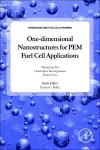
One-dimensional Nanostructures for PEM Fuel Cell Applications
3 authors - Paperback
£47.95
After a first degree in Materials Science and Engineering, Tsinghua University and a PhD degree in Chemical Engineering from the Institute of Process Engineering, Chinese Academy of Sciences, China, in 2005, Shangfeng DU moved to the Max Planck Institute for Metals Research, Germany. After that, he joined the Centre for Fuel Cell and Hydrogen Research (CFCHR) at the University of Birmingham (UoB), UK, supported by Marie Curie Incoming International Fellowship (IIF) (awarded in 2006). At UoB, he collaborated with Prof Kevin Kendall FRS, a pioneer in the field of particles and fuel cells (builder of the famous JKR adhesion theory, retired in 2011). In 2009, Shangfeng was awarded a research fellowship from the Science City Research Alliance (SCRA) through the Higher Education Funding Council for England (HEFCE) Strategic Development Fund and established himself as an independent researcher. In 2015, Shangfeng was appointed as a lecturer and built the Low Temperature Fuel Cell Research Group as part of the Centre. Shangfeng DU has spent 10 years researching electrodes for low temperature fuel cells and the characterisation of nanoparticle behavior for energy and health applications. He is recognized for his expertise in the field of one-dimensional (1D) materials for fuel cell applications, and has introduced the unique category of integrates thin film electrodes from 1D nanostructures for PEMFC application. Shangfeng is an Editorial Board Member of Scientific Reports, and has authored more than 40 original refereed papers, reviews, book and book chapters. Christopher Koenigsmann completed a Ph.D. from Stony Brook University under the mentorship of Professor Stanislaus S. Wong. He completed postdoctoral studies at Yale University in the Department of Chemistry and the Energy Sciences Institute with Professor Charles A. Schmuttenmaer. Currently, he is an Assistant Professor of Chemistry at Fordham University and is the Director of the Undergraduate Teaching Assistant and Tutor Program. His research group’s interests focus on the synthesis and development of functional nanomaterial architectures that are designed to increase the performance and cost-effectiveness of renewable energy and sensor devices. Shuhui Sun is an Associate Professor at the Institut National de la Recherche Scientifique (INRS), center for Energy, Materials, and Telecommunications, Canada. His research is focused on the development of multi-functional nanomaterials for Energy and Environmental applications including PEM fuel cells, Batteries, and Wastewater treatment. He has published 4 book chapters and more than 80 peer reviewed articles. These publications have earned him to date more than 4000 citations with H-index 31. He is also listed as inventor on 2 US patents. He received various honors, including Governor General's Academic Gold Medal (Canada), and member of Global Young Academy (GYA). Bruno G. Pollet is a full Professor of Renewable Energy at the Department of Energy and Process Engineering at the Norwegian University of Science and Technology (NTNU) in Trondheim. His research covers a wide range of areas in Electrochemical Engineering, Electrochemical Energy and Sono-electrochemistry (the use of Power Ultrasound in Electrochemistry) from the development of novel materials, hydrogen fuel cell to water treatment/disinfection demonstrators & prototypes. He was a Professor of Energy Materials and Systems at the University of the Western Cape (South Africa) and R&D Director of the National Hydrogen South Africa (HySA) Systems Competence Centre. He was also a co-founder and an Associate Director of the University of Birmingham Centre for Hydrogen and Fuel Cell Research in the UK. He was awarded a Diploma in Chemistry and Material Sciences from the Université Joseph Fourier (France), a BSc (Hons) in Applied Chemistry from Coventry University (UK) and an MSc in Analytical Chemistry from The University of Aberdeen (UK). He also gained his PhD in Physical Chemistry in the field of Electrochemistry and Sonochemistry at the Coventry University Sonochemistry Centre.